Di Daniela
Scroll down for English version
SALSE
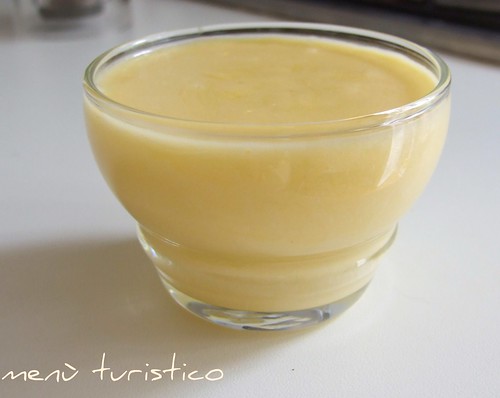
"La parola salsa deriva dal latino "salsus" (salato), perchè è sempre stato il sale il condimento base di ogni cucina. Già in Mesopotamia nel III millennio a.C., poi in tutto il Meditteraneo, era diffuso l'impiego di salse per condire quasi tutte le preparazioni. Presso gli antichi Romani era famoso il garum (un condimento molto forte ndr.) , ma spezie ed erbe aromatiche (senape, coriandolo, cumino, aneto, timo, aglio, zafferano o pepe) venivano frequentemente utilizzate, come è riportato in Apicio, per salse e intingoli che costituivano una parte molto importante nella cucina romana. Si legge in Ateneo che tutti amavano i condimenti e che senza di questi nessuno avrebbero mangiato volentieri carne e pesce. Era importante, per la buona riuscita di un banchetto, conoscere le salse e quindi le spezie e, soprattutto, era importante saperle accompagnare ai cibi. Si legge, a questo proposito, in Orazio che non bastava, al mercato, prendere dal costoso banco dei pescivendoli tutti i pesci se non si conosceva la salsa che li avrebbe poi accompagnati. Le salse modificavano il sapore dei cibi, li rendevano più gustosi anche se non si poteva certo dire che il loro odore fosse altrettanto invitante. Plauto infatti dice che l’odore che si sprigionava dalle salse era analogo a quello che derivava dalla mescolanza del sudore e degli unguenti. Abbondante pepe e vino rendevano più saporite le biete insipide, e il solo pepe era consigliato per accompagnare un beccafico così come, ancora il pepe, veniva utilizzato per condire un pollo fatto a pezzi e cucinato in casseruola con brodo bollente. Plinio ricorda che la menta fresca, il cui aroma stimolava l’appetito, veniva unita in ugual misura alla lattuga per accompagnare piatti di pesce o di uova. Nel ‘300 Guillaume Tirel (il Taillevent, primo cuoco professionista francese di cui si conservi memoria) contribuì ad esaltarne la preparazione nel più antico libro di cucina francese: “Le Viandier”. Successivamente, sembra che i cuochi fiorentini arrivati alla corte di Francia con Caterina de' Medici (XVI sec.), arricchirono la varietà delle salse anche con il probabile antenato della besciamella: “lo bianco mangiare”. Sempre presso la corte di Francia, i cuochi spagnoli al seguito di Anna d'Austria (XVII sec.), portarono la salsa spagnola o bruna. Le salse possono essere sia calde che fredde. Talleyrand, principale esponente politico francese durante il Congresso di Vienna (1814), di fronte ai rappresentanti della Gran Bretagna, massima potenza della coalizione vincitrice, si consolava affermando: " L'Inghilterra ha tre salse e 360 religioni, la francia a tre religioni e 360 salse". Le calde, utilizzate sopratutto nei ricettari “professionali”, elencano fra le più importanti le così dette “salse madri”: la besciamella, la vellutata o bianca, la spagnola o bruna, e la salsa di pomodoro. Da queste originano tutte le altre, battezzate da Escoffier "les grandeurs” dell'arte culinaria francese, rappresentano una versione aristocratica degli intingoli della cucina popolare. Le salse fredde, che hanno contribuito ad arricchire i sapori della cucina casalinga, si può dire che derivano quasi tutte dalla maionese, chiamata anche “salsa condottiera”. "
Mi sembrava così esauriente e ben scritto questo brano che non ho potuto far altro che riportarlo integralmente. L'ho trovato su
taccuini storici , un sito pieno di curiosità e notizie interessanti sul cibo. Vorrei solo aggiungere che la salsa Olandese è anch'essa una "salsa madre" perchè da lei partono diverse varianti che, a seconda dell'ingrediente aggiunto o variato, si trasforma in:
Maltaise- Aggiungete 1 cucchiaio di succo d'arancia e 1 cucchiaino di buccia d'arancia grattugiata, dopo che il burro è stato assorbito e tornate al calore. Cuocete fino a che non si è addensata.
Mousseline - Aggiungete circa 1 / 2 tazza di crema dopo che il burro è stato assorbito e tornate al calore. Cuocete fino a che non si è addensata
Mikado - Utilizzate la stessa procedura Maltaise, ma utilizzate invece mandarini.
Olandese magra- con 250 di yogurt magro e 4 tuorli oltre a limone e pepe (da cuocere a bagno maria)
Senape- Basta aggiungere un cucchiaio di senape di Digione o la vostra preferita, alla fine
Béarnaise - 1 cucchiaino di aceto al posto dell'acqua e alla fine aggiungete macinati scalogno e dragoncello . La Bernaise pur essendo una salsa derivata, può essere a sua volta, ulteriormente modificata (per esempio avremo la Paloise se invece del dragoncello mettiamo la menta, la Choron invece, aggiungendo un cucchiaio di passata di pomodoro ).
Tutto questo per introdurre un post incentrato sulla preparazione della salsa olandese e di alcuni suoi derivati avendone accennato parlando degli asparagi.
Partiamo allora
SALSA OLANDESE
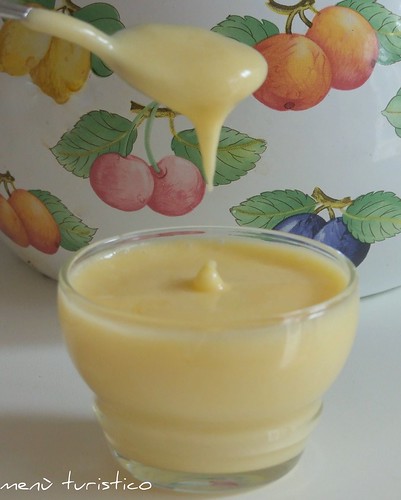
Ricetta tratta dal mio magico "talismano della felicità" di A. Boni
Per 6 persone (per 1/4 di litro di salsa)
Prendete una casseruola a bordi alti e metteteci 25 gr di burro, la fecola di patate, 3 cucchiai di latte, i tuorli d'uovoe il sale e con una frusta sbattete a freddo questi elementi; mettete poi la casseruola sul fuoco a calore molto moderato e continuate a sbattere finchè il composto non sia diventato spesso e cremoso (5 minuti circa). Dividete il rimanente burro a pezzetti. Levate la casseruola dal fuoco, metteteci un pezzetto di burro e riportatela subito a calore debolissimo, sempre sbattendo per far assorbire il burro dall'uovo. Continuate così fino all'esaurimento del burro (o vostro he he !!) sempre continuando a mescolare con la frusta (altri 5 minuti). Finito di inglobare il burro fate assorbire con lo stesso metodo anche due cucchiaiate ulteriori di latte (nella mia non sono state necessarie). Completate la salsa con succo di limone e pepe.
Se non dovete servirla subito, tenete la casseruola in caldo a bagnomaria, perchè raffreddandosi tende a "dividersi".
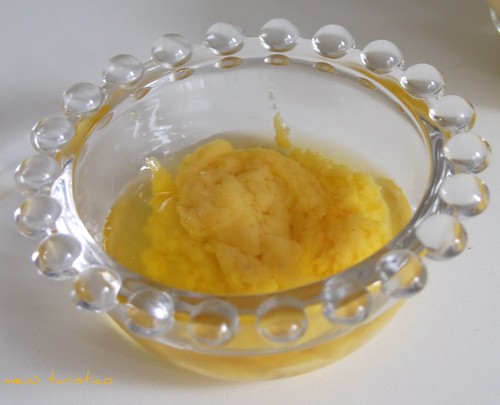
(questa me la sono dimenticata sul fuoco mentre correvo a prendere la macchina fotografica!!)
Se malgrado le vostre precauzioni dovesse scomporsi, travasatela in una terrina e fatela raffreddare. In un altra casseruola mettete un rosso d'uovo e sempre sbattendo con la frusta, aggiungete a filo , come per la maionese, la salsa "scomposta" , e continuate a frustarla finchè non riprende corpo.
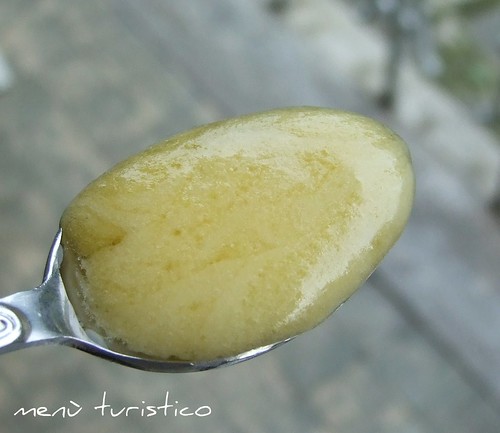
La salsa olandese è perfetta per uova sode, verdure (asparagi!!!), pesci lessi e pollame.
Buon appetito
Daniela
SAUCES
"The word sauce comes from the Latin word" salsus "(salty), because salt has always been the foundation of all the seasoning cooking. Already in the third millennium BC in Mesopotamia, then throughout the Mediterranean sea, widespread the use of sauces to dress almost all preparations. Among the ancient Romans were famous garum (A very taste seasoning), but herbs and spices (mustard, coriander, cumin, dill, thyme, garlic, saffron and pepper) were frequently used, as is shown in Apicius, for sauces and gravies which constituted a very important part in Roman cuisine. Ateneo wrote that everyone loves condiments and that without these, no one would willingly eat meat and fish. It was important for the success of a feast to know the sauces and spices and, above all, it was important to know how to accompany the food. Horace says that was not enough, at the market, take from the expensive bank of the fishmongers all fishes if you do not know which sauce can be served with them. Sauces change the taste of food made them tastier even if you could not really say that their smell was just inviting. Plautus says that the smell that emanated from sauces was similar to that derived from the mixture of sweat and ointments . Pepper and wine made the insipid chards more flavorful, and the only pepper was recommended to accompany a warbler as well as, still pepper, was used to flavor a chicken cut into pieces and cooked in a pot with boiling broth. Plinio observes that the fresh mint, whose aroma stimulates the appetite, was united in equal measure to the lettuce to accompany fish or eggs. In '300 Guillaume Tire (Taillevent the first professional French chef whose memory is preserved) helped to exalt the preparation in the oldest book of French cuisine : "The Viandier." Subsequently, it appears that the Florentine chefs come to the French court with Catherine de 'Medici (XVI sec.) enriched the variety of sauces with the likely ancestor of the white sauce (béchamel): “the white eating”. Also at the court of France, the Spanish chefs in the wake of Anne of Austria (XVII sec.) carried the Spanish sauce or brown sauce. The sauces can be hot or cold. Talleyrand, main French politician during the Congress of Vienna (1814), in front of the representatives of Britain, the maximum power of winning coalition, consoled himself by saying: "England has three sauces and 360 religions, France has 360 sauces and 3 religions. The warm , mainly used in recipes "professional", list the most important so-called "mother sauces”: béchamel, or the velvety white, Spanish or brown, and tomato sauce. From these arise all the others, and they’re named by Escoffier "les grandeurs" of culinary French, and are an aristocratic version of the popular cooking sauces. The cold sauces, which have enhanced the flavors of home cooking, we can say that almost all derived from mayonnaise, also called "salsa leader."
These post seemed so comprehensive and well written that I quote it completely. I found it on “TACCUINI STORICI"(historian notebooks), an Italian site full of curious and interesting news on food. I would just add that from the hollandaise sauce, another "mother sauce", you can obtain different versions, depending on the ingredient added or changed, it becomes:
Maltais : add 1 tablespoon of orange juice and 1 teaspoon grated orange peel, after the butter has been absorbed and return to heat. Cook until it thickens.Mousseline : Add about 1 / 2 cup cream after the butter has been absorbed and return to heat. Cook until it thickensMikado : Use the same procedure Maltais, but rather to use mandarin.
Dutch lean : with 250 of yogurt and 4 egg yolks and lemon pepper as well (to be cooked in a water bath)Mustard-Just add a tablespoon of Dijon mustard or your favorite in the end
Béarnaise : 1 tsp vinegar instead water add minced shallots and tarragon in the end. The Bernaise sauce while derivative, may itself be further amended (for example if we have the Paloise with tarragon instead of mint, or Choron , adding a tablespoon of tomato paste).
All this to introduce a post focused on the preparation of hollandaise sauce and some of its derivatives, having mentioned them talking about asparagus.Let's start withHollandaise sauce

Recipe is from my magic “TALISMANO DELLA FELICITA" by A. Boni
For 6 people (1 / 4 liter of sauce)
1.7 stick butter
2 egg yolks
1 / 2 cup milk
1 tsp of potato starch
salt
lemon juice
pepper
Take a casserole with high sides and put inside 1.5 tbsp of butter, potato starch, 3 tablespoons milk, egg yolks and salt. Whisk them and, then put the saucepan on the fire to very low heat and continue to whisk until the mixture has become thick and creamy (5 minutes). Divide the remaining butter into small pieces. Lift the pan from the heat, put a bit of butter and return it immediately to weak heat, always beating the egg to absorb the butter. Keep going until all the butter is absorbed, while continuing to stir with a whisk (5 minutes). When all the butter is incorporated, add in the same way two more tablespoons of milk (in my sauce not have been necessary). Finish the sauce with lemon juice and pepper.If you don’t serve the sauce immediately, keep the pan in hot water bath, because cooling it tends to "separate".

( I've forgotten this on the fire as I ran to take the camera )
If despite your precautions the sauce “impazzisce” (separate), put it in a bowl and let cool. In another saucepan put an egg yolk and always beating with a whisk, add wire, as for mayonnaise, salsa separated, and continue to whip until it becomes thick and creamy again.
Bon appetit
Dani



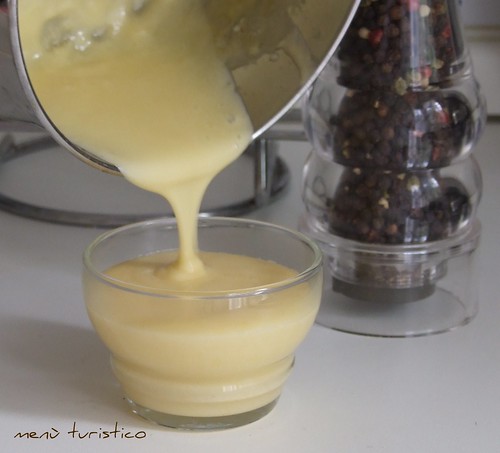


Ciao! noi siamo delle fan delle salsine di accompagnamento!! ottime tutte quelle che proponi..comincieremo da quella classica olandese...!
RispondiEliminaun bacione e grazie per tutte le utilissime info che ci fornisci in ogni post!
la salsa olandese mi fa impazzire sul pesce.... la trovo delicatissima! buona giornata :-)
RispondiEliminache bello questo post!!!!
RispondiEliminami segno la ricetta!!
Buona e senza glutine la salsa, colta e raffinata la cuoca! Lo sai che Caterina porta anche l'uso della forchetta in Francia? Noi italiani siamo comunque sempre oltre!!!
RispondiEliminaBaci
Stefania
Ciao complimenti è deliziosa!!!! e poi non sapevo fosse la base per creare altre salsine...tutte sfiziose...un bacio
RispondiEliminaCiao!! Ho appena pubblicato il PDF "Tea recipes"!! Passa dalla mia cucina per poterlo scaricare gratuitamente!!
RispondiEliminaMa non finisce qui!! Il signore del tè ha in serbo una piccola sorpresa per le partecipanti!!!
Bacio!!
Buona la tua salsa un condimento perfetto per ciò che hai suggerito. Ciao.
RispondiEliminachebbuona la salsa olandese!!!! io l'ho fatta una sola volta, ma è andata letteralmente a ruba! e grazie per la bellissima introduzione sulle salse e per le dritte sulle varianti possibili! non le conoscevo!
RispondiEliminaciao ciao
Vale
è buonissima, io l'adoro, la accompagno anche ai crostacei.... bravissima e grazie per la spiegazione!!!
RispondiEliminaPER TUTTE : grazie della vostra gentilezza: ho sempre l'ansia di far la figura della maestrina rompi. Ma , tanto per darvi l'idea io vi ripropongo solo quello che imparo leggendo qua e là. Perciò mi fa proprio piacere non annoiarvi!!!!
RispondiElimina@ciao ragazze!! Mi fa piacere avervi dato un'idea sfiziosa. Un bacino a tutte e due
@ Babs anche a me è piciuta sul pesce, ma devo dire che con gli asparagi e un goccino di limone in più l'ho trovata proprio perfetta!! Un bacione
@ Alem a presto e un bacio
@ Stefi grazie per l'ulteriore notizia e grazie anche per il bel post su Praga. Bacioni
@ susina: domattina sarò da te!! Grazie
RispondiElimina@ Max grazie a te e un abbraccio
@ Vale, la fantasia è pazzesca: cosa si riesce a combinare con un uovo e qualche pizzico di poche altre cose!! Bacini
@ Colombina : é un piacere imparare insieme!! Baci